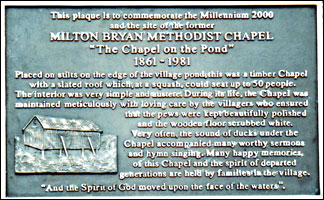![]()
The contents on this page remain on our website for informational purposes only.
Content on this page will not be reviewed or updated.
 |
|
 |
|
|
||||
|
Milton Bryan's Commemorative Plaques
|
||||
|
||||
|
Milton Keynes Citizen, April 5, 2012
Whilst perhaps not blessed with the ability to walk upon water, those of the Methodist faith in Milton Bryan were at least once able to walk across the waters, for their chapel was supported on stilts above the village pond. By the later 19th century they had been holding their meetings in a local cottage but their ultimate aim was to have a purpose built chapel. Yet no one would allow them a site and when one farmer who had bitterly opposed their plans died from a wasp sting many considered it to be an act of Divine retribution. Possibly not wishing to suffer the same fate, the Duke of Bedford then granted the use of the village pond - which was then much larger than at present - but due to a stipulation that the chapel had to be erected between sunrise and sunset, and not during the day, the sections of the building were made at Dunstable and then, supposedly in the middle of the night, brought to Milton Bryan to be bolted together. Supported above the pond on stilts, in the early days the chapel was known as the Tabernacle and for some 100 years would become an unusual centre for weekly worship. Initially an annual rent of 2s 6d was payable to the lord of the manor but in time the Duke of Bedford relinquished this ‘peppercorn’ amount and sold the right to the trustees. Of little surprise, in such a moisture laden situation by the late 1970s the chapel had begun to deteriorate and the slated roof and much of the internal furnishing had to be removed. Then damp set into the woodwork and in consequence during the early weeks of 1981 the building was demolished. The timbers were piled up at the side of the pond and no trace of the chapel now remains. However, a plaque to commemorate the chapel and the millennium was erected in 2000, for which year the village also saw the beginnings of another commemoration and plaque, for the ‘black propaganda’ World War Two radio station situated at the other end of the village. It had been during 1942 that on a remote corner of the Woburn estate construction began of this squat, symmetrical, brick building, guarded when complete by steel fencing and armed personnel. During the earlier years of the war information gained from German prisoners had been used by foreign teams, housed in the local area, to record ‘black broadcast’ programmes onto wax discs at Wavendon Towers, which were then taken by Secret Service cars to covert transmitting stations in the district. The intention was solely to deceive, dishearten and demoralise the German audience, and convince them of a growing underground movement deep in Germany. Indeed upon this belief hinged the whole credibility of the operation and pornography to appeal to the enemy soldiery, as well as language offensive in the extreme about the British, was deliberately employed. However, the physical size of the discs limited the length of a programme to 20 minutes each side and so in 1943 the purpose built station at Milton Bryan came into operation, with broadcasts transmitted on shortwave. Then at Crowborough, in Sussex, an ultra powerful transmitter from America was installed and, with this being able to swamp any German radio station, a direct link was laid to Milton Bryan. Thus here the studio announcers could mimic and take over a German station and with the German audience none the wiser all manner of false information was relayed. Also mimicked were the ground controllers directing German fighter aircraft, sending them all over the sky on false missions. In 2000, the research regarding this wartime story formed the basis of a website created at the Open University and when this came to the attention of Channel 4 it provided much information for their documentary on the subject. The full story is also told in a recent book and DVD whilst as for the plaque, this was unveiled by the now Duke of Bedford on September 4th 2002, in fact possibly being the first to carry a website address! |
||||
|
|
||||
|
|
||||


